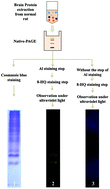当前位置:
X-MOL 学术
›
Toxicol. Res.
›
论文详情
Our official English website, www.x-mol.net, welcomes your
feedback! (Note: you will need to create a separate account there.)
Identification of the Al-binding proteins that account for aluminum neurotoxicity and transport in vivo†
Toxicology Research ( IF 2.2 ) Pub Date : 2017-12-01 00:00:00 , DOI: 10.1039/c7tx00261k Dai Cheng 1, 2, 3, 4, 5 , Xiaomei Wang 6, 7, 8, 9 , Yu Xi 6, 7, 8, 9 , Jiankang Cao 6, 7, 8, 9 , Weibo Jiang 6, 7, 8, 9
Toxicology Research ( IF 2.2 ) Pub Date : 2017-12-01 00:00:00 , DOI: 10.1039/c7tx00261k Dai Cheng 1, 2, 3, 4, 5 , Xiaomei Wang 6, 7, 8, 9 , Yu Xi 6, 7, 8, 9 , Jiankang Cao 6, 7, 8, 9 , Weibo Jiang 6, 7, 8, 9
Affiliation

|
Studies have shown that aluminum (Al) is the most abundant neurotoxic element on Earth, and is implicated in the pathogenesis of Alzheimer's disease (AD). However, the mechanisms underlying Al-induced neurotoxicity are still largely elusive. Based on affinity analyses with Al and LC-LTQ-MS, we have found that serum albumin, brain CK-B and 14-3-3ζ protein have a high affinity for Al3+, and albumin has a much stronger affinity for Al than transferrin. The normal activity of CK-B, and physiological combination of 14-3-3ζ with tau can be severely perturbed by Al. We anticipate that our assay will provide a new focus concerning the mechanism underlying Al-induced neurotoxicity, and aid the design of strategies to prevent AD and other human diseases related to Al overload.
中文翻译:

鉴定导致铝神经毒性和体内转运的Al结合蛋白†
研究表明,铝(Al)是地球上最丰富的神经毒性元素,与阿尔茨海默氏病(AD)的发病机理有关。然而,铝诱导的神经毒性的潜在机制仍在很大程度上难以捉摸。基于对Al和LC-LTQ-MS的亲和力分析,我们发现血清白蛋白,脑CK-B和14-3-3ζ蛋白对Al 3+的亲和力高,而白蛋白对Al的亲和力比对Al 3+的强得多。转铁蛋白。Al会严重干扰CK-B的正常活性以及14-3-3ζ与tau的生理结合。我们预计我们的测定法将提供有关铝诱导的神经毒性的潜在机制的新焦点,并有助于设计预防AD和其他与铝超负荷有关的人类疾病的策略。
更新日期:2017-12-01
中文翻译:

鉴定导致铝神经毒性和体内转运的Al结合蛋白†
研究表明,铝(Al)是地球上最丰富的神经毒性元素,与阿尔茨海默氏病(AD)的发病机理有关。然而,铝诱导的神经毒性的潜在机制仍在很大程度上难以捉摸。基于对Al和LC-LTQ-MS的亲和力分析,我们发现血清白蛋白,脑CK-B和14-3-3ζ蛋白对Al 3+的亲和力高,而白蛋白对Al的亲和力比对Al 3+的强得多。转铁蛋白。Al会严重干扰CK-B的正常活性以及14-3-3ζ与tau的生理结合。我们预计我们的测定法将提供有关铝诱导的神经毒性的潜在机制的新焦点,并有助于设计预防AD和其他与铝超负荷有关的人类疾病的策略。











































 京公网安备 11010802027423号
京公网安备 11010802027423号